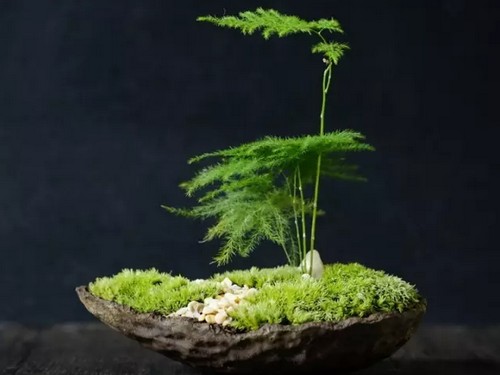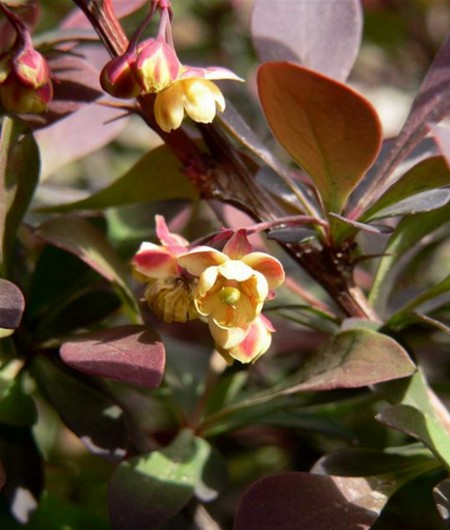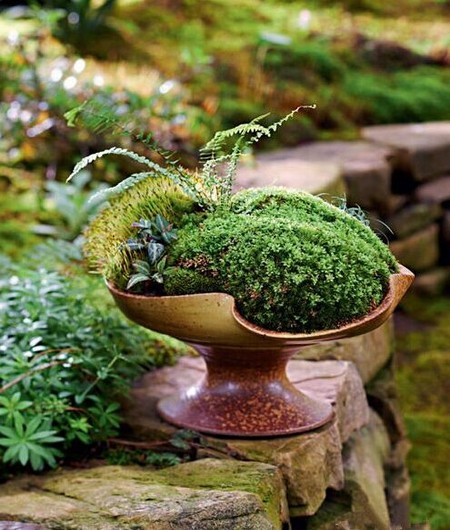Illustration of the production method of bonsai moss
Generally speaking, moss plays a role in keeping moisture in bonsai as a shop on the basin soil, but the moss is spread separately in the water stone basin and watched independently as a moss bonsai, which actually has a different charm. As the saying goes, "one-third of grass and seven of people". Every morning, get down and feel the primitive savagery with the moss.

Moss is an indispensable part of tree bonsai, miniature landscape bonsai or flood and drought bonsai. It can increase the content of the scenery, enrich the color of the scenery, and multiply the ornamental value of the works. (moss secretes acid metabolites to corrode rocks, promote rock decomposition and weathering, and promote the formation of soil. Moss is also a pioneer in the growth of other plants.) Moss can not only prevent soil erosion, water and moisture, etc.
1. Rapid coating method
Soak the bonsai rocks in water for several days, then sprinkle them evenly on the rocks or basin soil with potato or potato powder, then cover them with moist weeds and spray water every day to grow moss in about a week.
2. Inoculation method of moss
Select a few pieces of loess, grind and add water to paste, mix the natural moss in the mud, brush evenly on the soaked rock or soil surface with a small brush, often spray water, and the moss can be seen a few days later. You can also dry the fresh moss, grind it into powder, mix it with water or thin rice soup, apply it where the bonsai needs, move the basin to the shady and wet place, and keep it moist, then you can produce moss.
3. The natural coating method
Put the prepared rocks in the basin, often water pottery rice water, pottery vegetable water, keep wet, put in the place where you can see the sky but not the sun, the water-absorbing stone is better.
4. Coating on basin surface
The moss used in the potted noodles of bonsai trees can be placed flat in a damp place where you can't see the sun in the sky, beat the original moss into mud and spread it evenly on the film, keep it moist, spray light fat and water once after emergence, and use it as needed for 15 days. Stick mud on the root surface of the moss pan, wet the basin soil, brush it with mud, and then paste it.
Moss lives in a damp and dark environment, so moss is usually found at the root of the dark and damp south wall, because its leaves are monolayer, so it is afraid of dryness. If it is forgotten to water for a few days, it will wither and yellow, but it will grow in a few days. In addition, if the temperature is too low, it will be withered and yellow, so it is best to keep it above 25 degrees.
Many flower lovers who like bonsai want to plant some small plants in bonsai, which are not only clean, but also moisturizing, and moss is the most commonly used, so many flower friends want to see bonsai moss to make diagrams. This article is based on their own experience. Hand-written bonsai moss to make illustrations.
1. Look for moss. There are many kinds of moss suitable for decorating bonsai, and the most important thing is that Tess is not too long. There are also many channels to get moss. Some friends buy it online, which shows that they are too rich. I calculated that the basin noodles of 30cm generally cost nearly 50 yuan. What we civilians do is to look for suitable plant materials on the ground, stones or tree trunks in the mountains. Of course, if you are from a large or medium-sized city, it will be difficult to do so, then your easiest way is to look under the solar panels of brick roofs, next to drainage holes, tile surfaces of tiled houses and outdoor drainage ditches.
2. Collect moss. Gently scrape off the whole piece along the bottom with a blade or bamboo stick.
3. Prepare some fine soil and pick up the larger particles with better viscosity.
4. Arrange the basin noodles. Hang up the rough layer of the basin with a knife or bamboo stick.
5. Sort out the moss. Gently clean up the large and fast wood residue rotten leaves at the bottom of the moss (if you don't have it, don't clean it up, because the collection channels are different, so some don't).
6. Prepare the basin noodles. After pouring the bonsai thoroughly, spread a layer of fine soil evenly on the basin surface, generally no more than 1cm, and then water the fine soil and gently stir it into a thin mud.
7. Cover with moss. The shape of each piece of moss you can gently tear off the edges according to the shape of the basin and the pattern you want to decorate, or you can use scissors.
8. Management in the future. Put the finished bonsai moss in the shade of the courtyard or in a cool and ventilated place at home, and spray water with a spray can every 1-2 days to keep the moss moist (it is important to keep the moss wet, otherwise the son will become dry), and the moss will slowly survive.
Time: 2019-05-26 Click:
- Prev

The method of making bonsai of Berberis amurensis
Purple leaf Berberis is an important color leaf shrub in landscaping, which is often composed of color blocks, ribbons and pattern flower beds with golden leaf privet and big leaf boxwood. Purple leaf berberis balls can be planted by the roadside or embellished in the lawn. In addition, purple leaf Berberis is also a good material for making bonsai. Because it is more shady.
- Next

Steps of making moss bonsai
Moss bonsai often has extraordinary performance on the balcony and wooden deck, and the performance in the garden is not weak, so it is suitable for half-hidden and half-hidden in hairpins and resveratrol bushes. When guests come to the house, it is very pleasant to move them back to the indoor exhibition, which brings green to the living space.
Related
- Fuxing push coffee new agricultural production and marketing class: lack of small-scale processing plants
- Jujube rice field leisure farm deep ploughing Yilan for five years to create a space for organic food and play
- Nongyu Farm-A trial of organic papaya for brave women with advanced technology
- Four points for attention in the prevention and control of diseases and insect pests of edible fungi
- How to add nutrient solution to Edible Fungi
- Is there any good way to control edible fungus mites?
- Open Inoculation Technology of Edible Fungi
- Is there any clever way to use fertilizer for edible fungus in winter?
- What agents are used to kill the pathogens of edible fungi in the mushroom shed?
- Rapid drying of Edible Fungi

